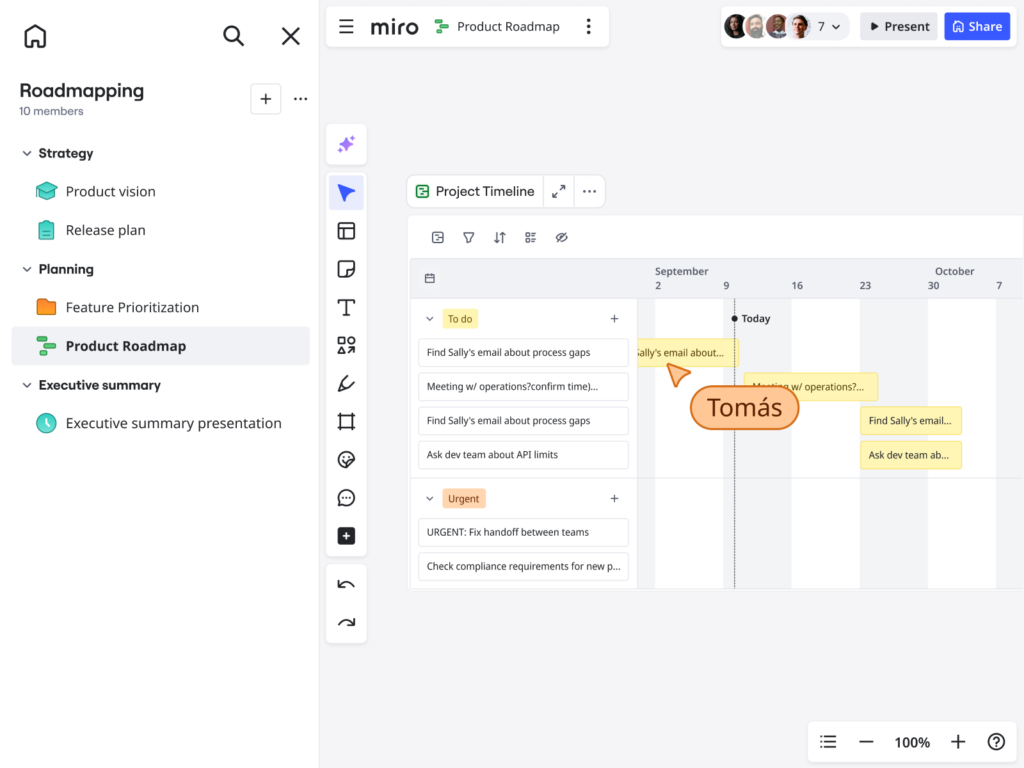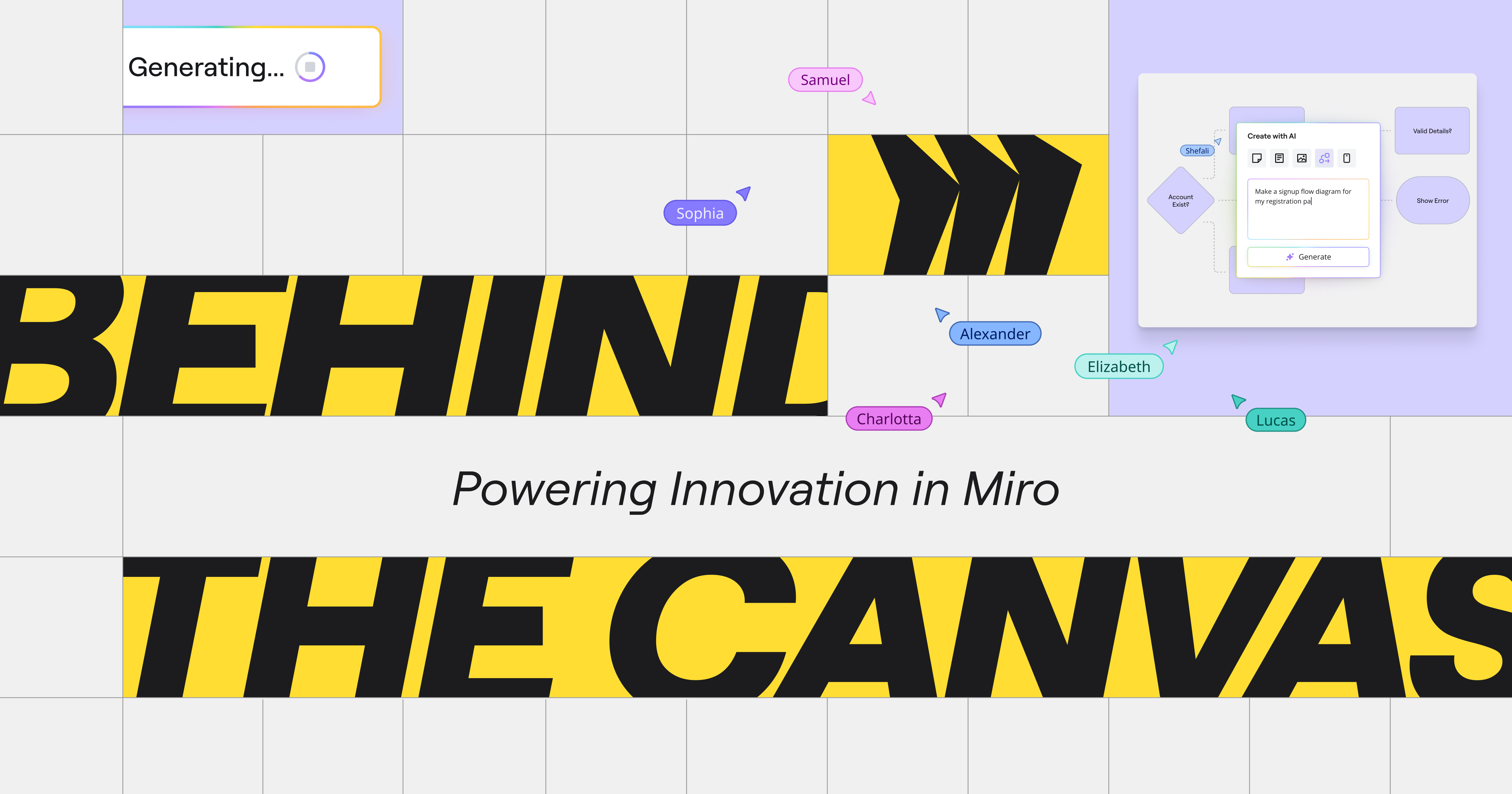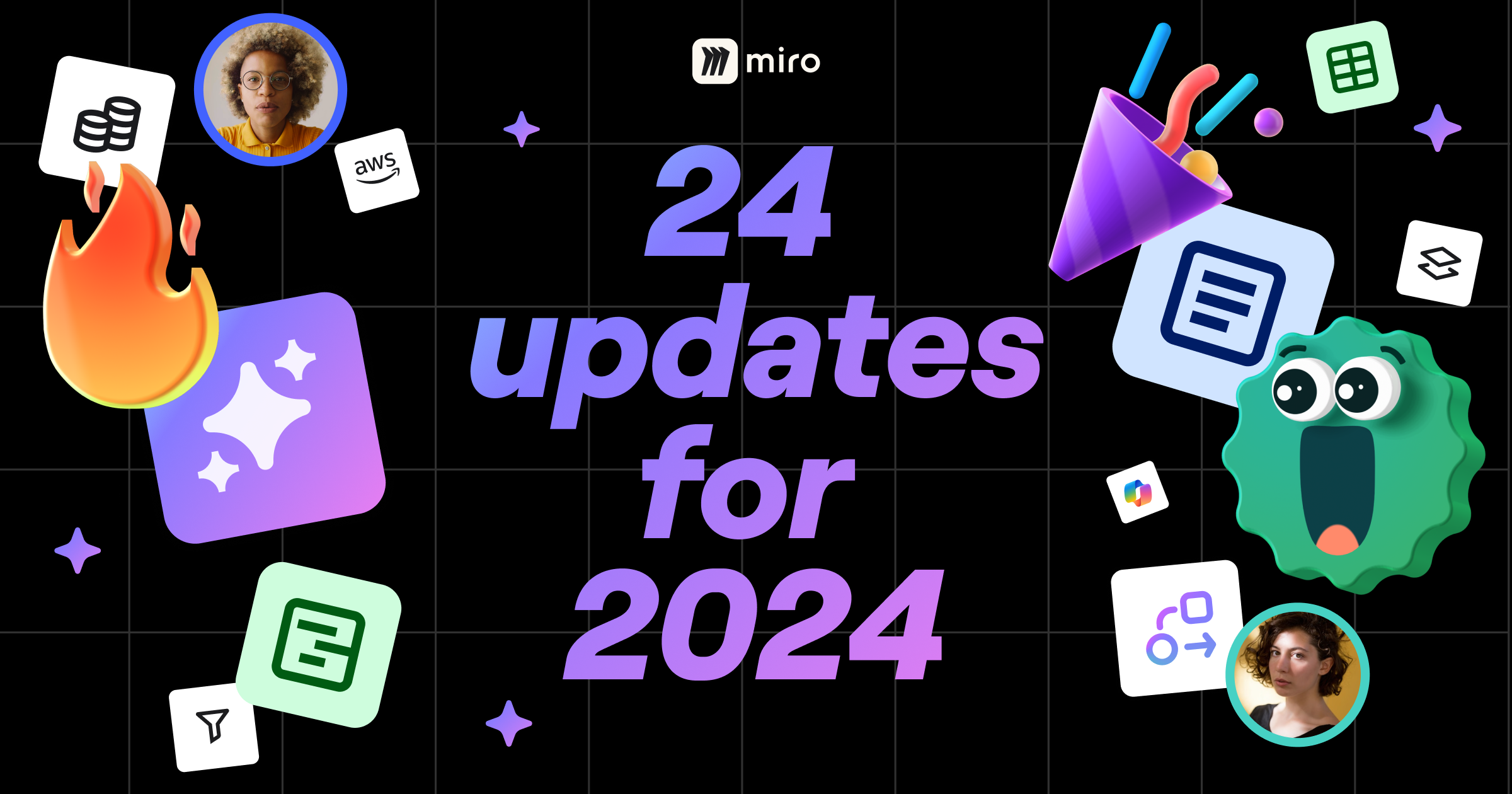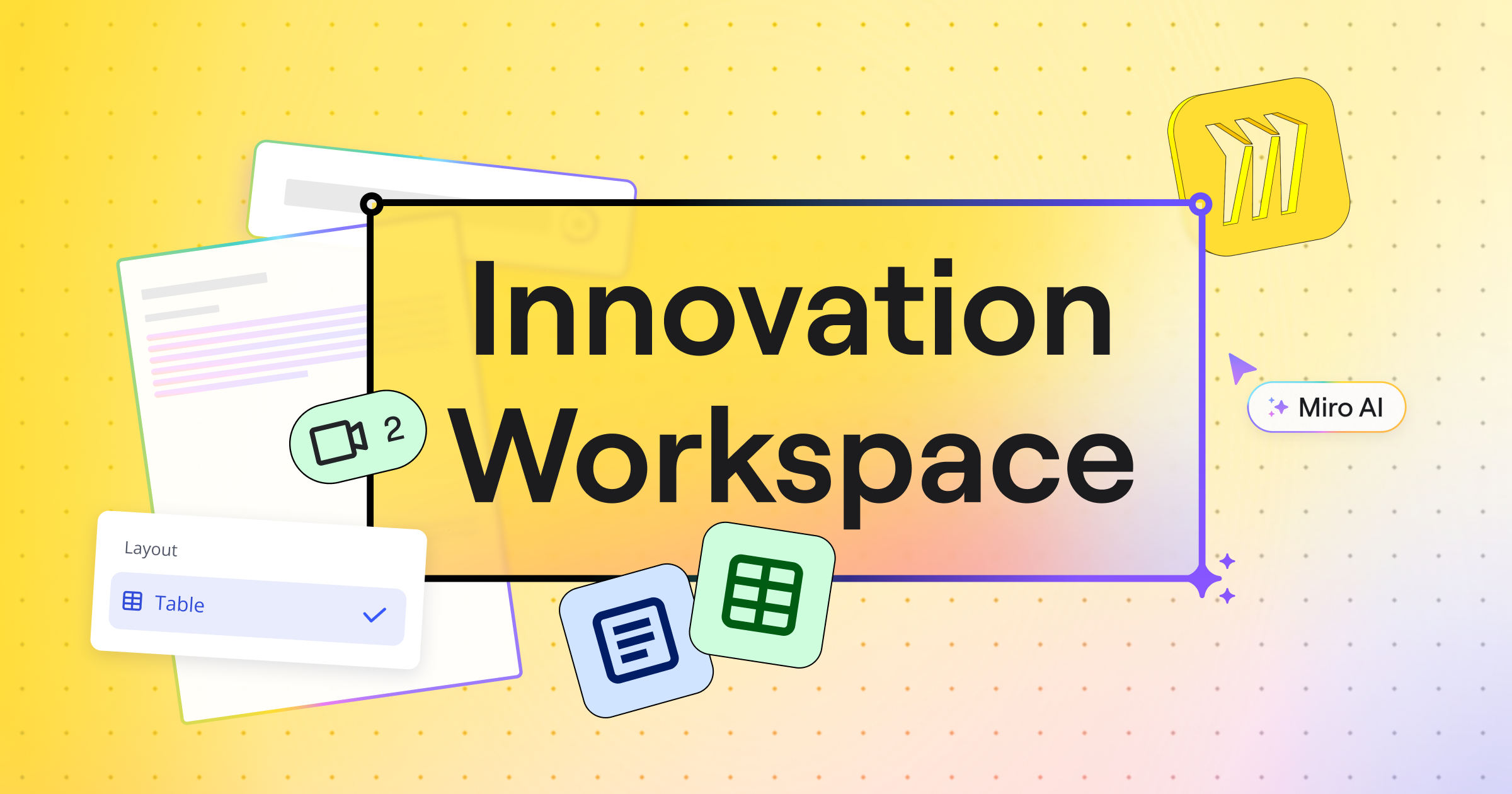We know that traditional ways of innovating are inefficient, fragmented, and slow. That’s why, according to McKinsey, only 6% of CEOs are satisfied with the way they do it. They don’t need an evolution. They need an intervention.
That means putting innovation to work by making sure it drives measurable outcomes for critical projects. So Miro is changing to meet the moment. We recently announced a number of new updates and feature launches to create a turbocharged system for faster collaboration with superpowers like composable workflows, flexible formats, and data-driven insights, all supported by AI baked into everything.
While we think everyone will benefit from a speed boost, we’re particularly excited to unleash the potential of Product teams so engineers, designers, and product managers can accelerate key use cases. And because they can’t do it alone, it also means improving collaboration and unlocking better ways of working across the business – especially with IT.
Product planning and roadmapping
Let’s unpack product planning and roadmapping to see how these new capabilities add up to a new way of working.
Traditional planning tools tend to run into a number of issues:
- Roadmaps quickly become overwhelming and hard to follow
- They end up as static artefacts that aren’t connected to specific tasks
- Without alignment there’s no shared responsibility
This is hardly surprising – planning is complex and cross-functional. It needs a deep synthesis of inputs including customer insights, market dynamics, technical constraints, and strategic priorities. All of which need to be weighed and translated into a clear direction.
Teams must align on objectives, define requirements, assess feasibility, and prioritize initiatives. They need to adapt as conditions evolve so that the roadmap becomes a living framework that continuously guides execution, iteration, and decision-making.
Miro enables organizations to navigate this complexity with speed and precision. Starting with a centralized Space, teams can work from a single source of truth. Everything that they need will be here – from a RACI to supporting documents to lessons learned in previous projects – so strategic decisions will always be grounded in the right context.
Even better, AI-powered tools can take all of this information and use it as a prompt to surface key insights, identify gaps, and suggest prioritization strategies informed by historical data. All of this means teams can get to the heart of the work faster, as AI takes a bunch of typically time-consuming tasks off their hands.
So then it’s time to do the work. Rather than starting from scratch on a blank board, product teams can now jump straight into a Blueprint for Roadmap Planning.
It provides a structured approach for teams to align on company-wide strategy, ensuring that all planning efforts are connected to overarching business objectives. It organizes key artifacts, facilitates team-level planning, and consolidates initiatives into a shared roadmap.

By gathering strategic inputs, defining team- specific goals, and structuring a clear execution plan, this blueprint enhances collaboration, prioritization, and visibility across departments. With real-time syncing, visual timelines, and stakeholder-ready presentations, it serves as a dynamic and adaptable framework for effective roadmap planning.
Not only are these boards customizable (think your brainstorm needs a SWOAR instead of a SWOT? Go right ahead and change it), they all have AI tools – and everything else – baked right in. Let’s say you’re using the product vision template. You’ve got dozens of sticky notes with suggestions and feedback. So you use the AI assistant to do the hard work of turning it into a structured doc. If it needs more work, just switch to Focus Mode, going full screen on the document to drown out any other distractions until it’s edited to perfection.
And because execution is just as critical as planning, Miro integrates seamlessly with Jira, Microsoft 365, and other core platforms, transforming the roadmap from a conceptual framework into a dynamic, action-driven plan. By creating a shared space where product strategy and execution coalesce, Miro enables organizations to move from vision to impact – faster and with greater confidence.
AI transformation
We’ve seen how Miro supports Product teams through better organization and customizable blueprints. Now let’s take a look at how we can help IT teams with a process that’s going to get a lot of attention from the C-suite this year: AI transformation.
Yeah, okay, #rollseyes and all that. But according to McKinsey, 92% of companies plan to increase their AI investment in the next three years. That means IT teams need to have an answer. But they can’t do it alone. Miro breaks down the walls between IT and the rest of the business so they can work together to define the opportunity, build a winning strategy, and manage their organization through the transition.
Miro is already the place where a lot of this work happens. That means it’s the perfect place to get stakeholders in sync: Running workshops on everything from strategic overviews to on-the-ground implementation, so every team can get on board – then get to work.
To make the process even faster, we’ve created two AI Transformation Blueprints. These customizable templates help teams run an AI capability assessment, map out human/AI touchpoints, plan the implementation, and track performance.
Not to get too meta, but teams can even use AI to crack the AI transformation code. For instance, by creating an Action Shortcut to auto-generate a list of AI use cases for consideration. They can also use Canvas Layouts to customize their Miro board for technical diagramming – taking advantage of all the tools and features you’re used to (multiplayer collaboration, super smooth UI, a full-screen Diagramming Format) with an added AI shape pack. So it’s easy to drag and drop AI agent icons, define human touchpoints, and set automation triggers.
As AI adoption accelerates, the companies that can design, implement, and scale AI workflows the fastest will have a major competitive advantage. With Miro, this transformation isn’t just an idea – it’s a structured, executable plan that puts strategy, workflow design and implementation tracking all in one place. And it actually uses AI to make AI delivery even faster.
How do we know it works? Because we’re doing it ourselves. “As a company that sits at the intersection of technology and innovation, it’s important that Miro is constantly embracing new and faster ways of working,” says Tomás Dostal-Freire, Miro’s CIO and Head of Business Transformation. “Using AI to define how our team members should partner with AI for their daily activities, give time back to employees to work on higher value-add initiatives, and ultimately improve our productivity and quality of output is a huge part of that. And of course we’ve mapped all of these workflows on Miro.”
In fact, Miro’s AI Transformation Blueprints are actually based on the processes Tomás and his team developed. “We were able to nail this workflow really fast,” he explains. “For one thing, we already have our entire business strategy and org structure already defined in Miro. And like most IT teams, we have a lot of experience running transformation projects. When you put those two things together, it’s pretty powerful. So even though ‘AI Transformation’ sounds like this incredibly difficult thing, what you find is that you already have a lot of the tools and expertise you need. Miro just supercharges the pace.”
“Even though ‘AI Transformation’ sounds incredibly difficult, you already have a lot of the tools and expertise you need. Miro just supercharges the pace.”
Of course, that expertise doesn’t only exist inside IT. For all that AI Transformation usually starts within the CIO organization, it’s relevant to all parts of the business. One of Miro’s greatest strengths is bringing together leaders from every department into a single workspace so they can define the vision and direction of their AI strategy together.




